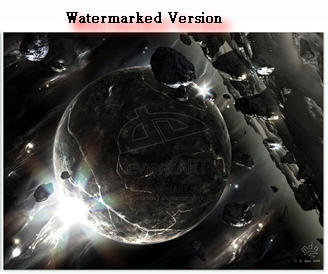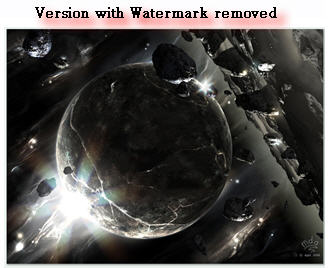Complicated things are often explained the best by making an analogy and using a simple real life example where people can relate to. Practical business examples and case studies that are based on a real project you worked on is also very good, but there is often the problem that you cannot share all relevant data and thoughts with the public, due to business interest and secrets that need to be protected.
Sure, the big successes and big blunders will make it out into the public, but those are not the best examples to be used for your average day to day stuff. Most things in life happen in between the two extremes and are, frankly speaking, boring. Try to talk to a friend or spouse about what you did at work on an average day and you will know what I mean with “boring“.
Let’s use Social Media as a (popular) example and its impact on traditional media publishing.
Famous examples are the Radiohead “Pay what you want” release of their latest album, the Nine Inch Nails and Prince albums give-away that followed as positive examples (not by everybody, but at least by the average Joe Consumer) and the Sony DRM Root Kit “inconvenience” as a negative example.
The good and the bad examples represent two different schools of thought.
Two Schools of Thought
The first represents old school and traditional thinking about your customers and your own products. It treats customers like little children that were left with you to look over them, somebody else’s children and not your own, like a babysitter. I have to say that I am referring to a patriarchic type of babysitter for the protection of the reputation of all the babysitters out there that do not do thing the way I describe now.
The patriarchic babysitter thinks that he knows what is good for them, do not expect them to know anything, but expect that they will follow the rules that you impose on them, trusting them not a bit that they will obey them, if you don’t make sure that they have no other choice. Punishment for disobedience ensures that the other children will follow the rules and reduces the chances that the perpetrator will repeat the same “mistake” again. Your stuff is off limits to the kids, with a few exceptions that you made perfectly clear and also expect to be respected. Almost every access to it is considered an exception and used as bonus for the ones who are behaving perfectly.
The second school represents a new way of thinking about your customers and your own products. Customers are more like your personal friends who you respect as person with their own opinions and thoughts that not always reflect your own. That your friends have other friends is perfectly fine and normal and nothing that you would worry about. You help them out if they are in need and let them borrow some of your stuff if you have it and they need it. If you have a lot of it and it’s not a big deal, then you might even let your friend have it permanently, especially if it is something that is needed frequently or for a longer period of time.
If you are a good person and do the things I mentioned, then you probably do not have a problem to find friends and the ones you have are loyal and helping you out in times when you need it. The patriarchic babysitter on the other hand will not have many children come to him voluntarily. The poor children sent over by their parents did not have much of a choice. They have at most some influence on their parents to make them find a different babysitter, who is hopefully a bit better. If children would have the power to make that choice every time, the patriarchic babysitter would probably find himself out of work fairly quickly.
The Transition Process
The developments over the past years seem to indicate that customers are not children and demonstrated time and again that they do have the power to make choices on their own.
That make me believe that this type of thinking is not going to last much longer and will make their way into the history books like the patriarchic type of marriage is already on its way to for many more years.
Things are not back and white and most stuff happens between the two extremes. There are companies who see their customers as adults, some even as friends, which is for many a new type of experience and something they are not accustomed to. This can look pretty sad or funny if somebody who is not doing this from his heart, but because he got told to do so, attempts to befriend you. The movie “Bicentennial Man” with Robin Williams from 1999 comes to mind.
The Giving Away Aspect
One part that I would like to discuss in more detail is the giving away stuff to your friends from time to time and why it helps to nurture the friendship or in translation to the marketing world, why giving away some of your stuff, especially the best that you have, for free to your customers instead of restricting access to it and overly protecting it as well.
A Real World Example
The example that I am using is from an artist community website where I am myself a member of. It is called deviantART.com. Artists of all ages from around the world can share their artwork with others, communicate with them, ask for feedback and opinion, form groups of like-minded or style-like artists and make your artwork available for purchase at the online shop that is fully integrated into the website.
There are many young teenagers using the site, some are great artists and others are not. It does not matter. Most of the members are not making much, if any money with their artwork, even for the good ones is it hard to get noticed.
One artist that I met and engaged in a discussion with is a young 19 year old gifted artist from Australia. He is a member of the deviantART.com community for over two years now and decided to watermark all his images and disable download of them. He hates people who take his art and do something with it, especially the folks at YouTube who make videos out of his stuff.
I liked one of his pieces but was annoyed by that ugly watermark that was very visible and distracting. Every member has the option to add any work from anybody to his own favorites or to personal collections. I would have done it with this piece, if it would not have been desecrated by the watermark. I also said that in the comment section for it.
He responded and told me about his fears about getting knocked off and finding his stuff elsewhere for not being credited for it. Those are very valid fears, but how he tries to prevent this stuff from happening impacts also the things he would like to have. He referred to another artist who is seemingly more popular than he is and that this other guy also has many friends who point out to him blatant abuses of his artwork and if somebody publishes his stuff without giving credits to him.
So I was curious about the question what makes the two artists different and the one seemingly more popular than the other. The idea to look at things a bit more closely was aided by the fact that deviantART.com provides a number of interesting statistics for each member and for each piece of artwork that was submit to the site and makes those statistics visible to everybody and not just the owner himself.
Long Disclaimer
The interpretation of those numbers is my own and somebody else might (probably) interpret the same numbers differently. Feel free to do so, as a matter in fact, I urge you to question my interpretations. Just the fact that I will throw numbers (hard figures) at you does not mean that my interpretation is absolute and out of the question. I also do not have all numbers and information that might be relevant and had significant impact on the outcome and visual effects of things.
Numbers are a tricky thing. They convey expertise and professionalism of the person who Is throwing them into the room and is often not questioned and scrutinized by others and accepted as absolute wisdom and truth. There is a saying in German that states: “Do not trust any statistics that you have not made/skewed yourself“. They can be used to proof or disproof any point that the person who is using them wants to make. I can tell you that I did not leave anything out intentionally and that my interpretations are honest and done with the best intentions, but that does not mean that that they are right and that you have to accept them.
Boy, nice disclaimer! I hope that I did not discredit myself with all this transparency and openness hehe. Another reason why I mentioned this is the fact that I do not have all the figures that I would like to have, but this is a problem that we face every day in our life. We have to make decisions and draw conclusions based on incomplete and sometimes skewed or incorrect information to virtually any subject that is relevant to us, professionally and personally.
Some Terms Defined
I will use some terms that need explanation.
- A deviation is any piece of artwork submitted to the deviantART.com website, usually an image or photograph or a picture of the artwork itself.
- Daily Deviations (DD) are handpicked deviations that are featured on the homepage and other main pages of the deviantART.com website. If one of your deviations gets selected, you will notice a huge spike in traffic and in comments made to the deviation and number of people who add it to their favorites. It could be compared to a “Digg Effect Lite” (see Digg Effect).
- “Watching” somebody means that the person who is watching you will receive notifications if you submit new artwork or write a new post in your personal journal. It’s like the friends activities page on Facebook, but the notifications are more like Google Alert messages and stay until you removed them from your inbox.
- A deviant is a member of the deviantART.com community
- dA is the abbreviation for deviantART. com. The lowercase “d” is a hallmark of the site.
General notes. You can virtually add comments to everything, unless it was disabled, including your profile, your artwork, your journal posts, your polls, your comments that you made elsewhere. There are forums as well, which are in a separate area, but you also could start a mini forum under your own account.
The Numbers
Here are the general stats for the artist, who I communicated with. His name is Matthew aka PriteeBoy (remark to the nick name: he is a model too, so don’t laugh). The artwork examples are copyrighted and were used with the explicit permission of the artist for this post.
 Matthew
Matthew
Male, 19 years old (born 1988) from Australia
| Total Figures | Averages |
| dA member since 02/2006 Page views: 33,152 Deviations: 95 Deviation comments: 6,900 Member comments: 2,500 Forum posts: 2,100 Deviants watching him: 833 |
Comments per deviation: 59.23 Favorites per deviation: 110.4 Views per deviation: 1,614.49 Comments per day: 6.85 Favorites per day: 12.77 Views per day: 186.76 Page views per day: 40.36 |
Average conversion 6.83% (people who view a deviation and add it to their favorites)
The other member, who is seemingly more popular, is a German (no, not me). His name is Tobias Roetsch aka Taenaron. The artwork examples were used with the explicit permission of the artist.
 Tobias
Tobias
Male, 20 years old from Germany
| Total Figures | Averages |
| dA Member since 07/2006 Page views: 112,701 Deviations: 30 Deviation comments: 5,000 Member comments: 7,200 Forum posts: 467 Deviants watching him: 2,541 |
Comments per deviation: 259.8 Favorites per deviation: 585.5 Views per deviation: 14,260.63 Comments per day: 11.8 Favorites per day: 26.61 Views per day: 648.17 Page views per day: 170.74 |
Average conversion 4.1% (people who view a deviation and add it to their favorites)
In my opinion is the rate at which people add deviations to their favorites a good indicator for the popularity of the work and its quality. Based on the average conversion of how many of the people who saw the artwork also bookmarked it afterwards, Matthew is doing significantly better than Tobias. It seems that Matthew’s artwork is in average liked more than Tobias’. Matthew also has more deviations which should also help, because the additional exposure and the chance to appeal to more and different people.
Why does Tobias have much more views and more exposure than Matthew does? Favorites lists by members are visible to other members and increase exposure even further. More deviations and the higher conversion rate should have put Matthew in the lead in general exposure as well. Why is that not the case?
Okay, I looked at some specific deviations and picked for each of the two a piece of their art that is among the most popular ones. I picked Matthews piece titled “High Rise” (print version) and Tobias’ piece titled “The Rise of a Planet” (Print version).
| Matthews Deviation “High Rise” Added on May 13, 2007 Page views: 19,956 Favorites: 1,403 Conversion: 7.03% Downloads: 474 (option now disabled) Became a “Daily Deviation” on July 3, 2007 |
 |
| Tobias Deviation “The Rise of a Planet” Added on October 15, 2006 Page views: 118,086 Favorites: 2,779 Conversion: 2.35% Downloads: 10,548 Became a “Daily Deviation” on October 20, 2006 |
 |
Matthew’s deviation conversion is a bit higher than his average and Tobias’ deviation conversion is significantly lower than his average, however, Tobias’ deviation got a lot more views anyway. The earlier submission and “Daily Deviation” does not account for this huge gap.
Noticed the download figures? This figure is very low for Matthew’s deviation and actually will not change anymore, because he disabled the download option for all his artwork. Many of his deviations show zero downloads for this reason, because he disabled it right when he uploaded it to the site. The deviation is also watermarked. Download for Tobias’ deviation is and was always enabled. Tobias does not watermark any of his stuff.
The measures Matthew put in place to prevent theft are questionable in regards to their effectiveness. You do not need a download option to rip off an image from a site, even if right-click and “save” does not work always (like at Flickr.com too). A watermark does also not protect his work from being knocked off by a determined forger.
 I demonstrated the latter to Matthew by taking one of his deviations titled “Obsidian Ore” and removing the watermark within a few minutes. I put it up, but as “scrap” (not visible in Galleries and search results) to show my point, but Matthew asked me to take it down now. I will honor his request and not show you the artwork. However, he gave me permission to use it here for this post, among the use of his other artwork, but with watermarks still intact.
I demonstrated the latter to Matthew by taking one of his deviations titled “Obsidian Ore” and removing the watermark within a few minutes. I put it up, but as “scrap” (not visible in Galleries and search results) to show my point, but Matthew asked me to take it down now. I will honor his request and not show you the artwork. However, he gave me permission to use it here for this post, among the use of his other artwork, but with watermarks still intact.
 However, the things he put in place make it harder for the average Joe user to share the artwork with friends. That the sharing features like the download option is used a lot is demonstrated nicely by the high download count for Tobias’ deviation.
However, the things he put in place make it harder for the average Joe user to share the artwork with friends. That the sharing features like the download option is used a lot is demonstrated nicely by the high download count for Tobias’ deviation.
I realized that I had to look beyond the deviantART.com community to find answers. The sharing features that are clearly designed for “off-deviantART” usage provided the clue.
deviantART pages are crawled by search engines and many also show in the search results. However, there are so many pages on the site that the search engines cannot index all of them. They have to make choices about what to index and also important, what to rank well in the search results page.
I used Yahoo! Site Explorer to find out what links to the two pages with the deviations. Note: every artist has his stuff on its own sub-domain, including galleries, journals, profile pages etc.
Matthew’s Deviation “High Rise” Linking Stats
- Inbound links to page: 70
- Inbound links not from the same sub-domain: 62 (not from pages in Matthew’s user space)
- Inbound links not from deviantART.com TLD: 0
- Google Toolbar Page Rank: No PR assigned (page is over 1 year old)
Tobias’ Deviation “The Rise of a Planet” Linking Stats
- Inbound links to page: 240
- Inbound links not from the same sub-domain: 197 (not from pages in Tobias’ user space)
- Inbound links not from deviantART.com TLD: 99
- Google Toolbar Page Rank: 3 (page is over 1 year old)
I checked some of the external links. It included blogs and also a Digg.com submission in November, 2007. It had 1,921 votes and 177 comments at digg.com (and made the home page of course)
Because of the popularity of the image Tobias decided to create wall paper versions of it for free download in five different resolutions: 1024×768, 1280×1024, 1600×1200, 1440×900 and 1920×1200.
This shows that Tobias embraces and even encourages sharing of his work with other people, at deviantART.com or elsewhere. This increases significantly the reach and exposure of Tobias’ work to much more people at many different places. Since credits were often given to him and links added to the source, traffic to his site increased as a result of this.
I hope that Matthew understands now what he should do to get the most out of things and increases his exposure and popularity, which in return will also increase his possibilities for professional and commercial success.
Conclusion, What does this mean?
Make your content and intellectual or creative work accessible and easy to share. Do not make it somewhat accessible and then stop half way through. It might prevent some theft and abuse, but it also prevents a lot the things that are good for you and your business. I dare to speculate that the gain from opening up and making things available without making people jumping through hoops is much greater than the negative side effects.
Some of the side effects might even get reduced again as a result of the gain in exposure and popularity and availability, because people are more likely to let you know if they come across the misuse or exploit of your work somewhere else to allow you to decide what actions you want to take against this abuse.
If you come across a site that shows your work and if it is clear that it is not used for commercial reasons, but because they love it and want to share it with friends, don’t ask them to take it down. Instead, ask them to add credits to it (if they have not already done so by themselves) and also have them add a link to your website that people who want to get in touch with you have a way to do so.
The people who are ripping off content and creative work for money won’t be stopped by a using stupid watermarks or disable download, if the content or design is that good. They rippers might move on and pick something else that requires less or no work, especially if the content is widely available and not that special, but that is beyond the point and could be the subject of a separate post. Regarding folks who are “fans” and put it on their website, video or what have not there is not much time you need to spend on it. Let me rephrase this: It is up to you, if and how much time you want to spend looking for your stuff online or offline.
A Practical Tip
But, when you come across it or somebody tells you about it, an email or comment (depending on where it is published) takes only a minute. You can keep a template message ready where you only have to change the greeting, the name of your content and optional a link to the place where you found it (for the email version of the message) and that is it.
Make it a nice message, if it is clear that somebody loved your art and effectively promotes you without having you pay a penny for it. A fan is the best spokesman, marketing and sales rep combined in one person. You just want to make sure that the promotion will be more effective by providing means to other visitors of that site to get in touch with you (link to your site, email etc.).
Tell them that you are flattered by what they did and that you do not mind that they used it (if you really do not), but that you would have liked that they had contacted you and simply ask. Not only that you would have known, but also because it is dear to your heart.
You might also had have been able to help them with what they did. Tell them that it would be nice and fair; if they would give you credit for your work by mentioning your name and adding a link to your site. This will enable other people who see your work on their site to get in touch with you and ask for permission to use some of your art.
That is a very valid reason and you basically imply that they found your artwork somewhere without credits and were not able to ask you for permission, that they would have done it by themselves already, if they had known and that you want to avoid for the future that some somebody else will run again into the same kind of problem.
Very nice, isn’t it? Link-building at its finest that even Link Moses would be proud of you.
Further Reading
If you plan to get more involved with social media, I would suggest reading my post here at Search Engine Journal, titled “Social Media Guide for Big Brand Corporate Business“.
Bonus
I think Radiohead did not go broke as a result of their pay what you want campaign, even though it was “knocked off” and downloaded or copied without paying a penny by an estimated 500,000 plus people. There are no exact figures available, but the low estimates alone are not looking bad at all, even though some folks speculate the opposite. All in all does it seem that their campaign was more of an accident and that they moved back home to their old patriarchic nanny for now.
Prince made a couple million off his little give-away.
Nine Inch Nails seem to be happy about how their campaign went and plan to continue to play around with the new concept. Publicity is guaranteed, but all this fame also creates its own problems, which can be overcome without problems though. A bit sweating and the problem will be gone :). Here are also some industry specific examples of giving away good stuff for free and having success with it. I thought that I throw them in as a bonus and to reinforce what I just wrote.
- Revenue Magazine, an industry print magazine that used to be sold for a fee is now given away free to people who qualify (are professionals in the industry)
- The SEOMoz.com Ranking Factors is probably one of the best pieces of content Rand and his crew produced and it is available free and not locked up behind his paid membership section walls. Do you think that it hurt their business or did it help?
- Always loved to be used as prime example, the Google Web Search. It is a free service and always was. This minor issue did not stop Sergey and Larry to cash in a couple billion dollars along the way, didn’t it?
- There are many more examples all around you. You must have noticed the one or the other already. They are hard to ignore these days.
Feel free to share with me and other readers your thoughts and opinion about this post in the comment section beneath the main post. Thank you and Cheers!
Carsten Cumbrowski is an internet marketing strategy consultant, affiliate marketer, blogger and entrepreneur. Carsten has many years of practical experience in online marketing. Check out the internet marketing resources site at Cumbrowski.com, it is free, no memberships, no strings attached.
p.s. If you are interested in how many prints each were sold, okay, here it is. Matthew sold only one print of his deviation “High Rise“. Tobias sold seven prints of his deviation “The Rise of a Planet” and 49 deviants added the item to their “wish list”. This is a horrible conversion in any case, but that has different reasons in my opinion and outside of the scope of this already very long post of mine. You can help skewing those numbers though, see “sales pitch” below. 🙂
Sales Pitch
I would be a mean and bad marketer, if I would not promote the work of the mentioned artists at least a little bit, wouldn’t I? It is also for a good cause, which makes it easier. Okay, here comes the sales pitch. Skip it, if you are not interested at all! 🙂
If you liked the images by Priteeboy and/or Taenaron, check out the deviantART.com print store, where you have multiple options to buy their artwork. “High Rise“, “The Rise of a Planet” are available as print “Obsidian Ore” to make it available for purchase as well.
 “The Rise of a Planet” is available as matte & glossy print ($50) and lustre print ($60) for the large 20×30 inches version, picture frame is optional for $32. Postcard sized prints, 4×6 inches, cost only $2 (matte/glossy) to $2.50 (lustre). Various other dimensions, in between the two mentioned, are available as well.
“The Rise of a Planet” is available as matte & glossy print ($50) and lustre print ($60) for the large 20×30 inches version, picture frame is optional for $32. Postcard sized prints, 4×6 inches, cost only $2 (matte/glossy) to $2.50 (lustre). Various other dimensions, in between the two mentioned, are available as well.
More artwork by Taenaron that is available for purchase.
 “High Rise” is also available as matte & glossy print ($15.50) and lustre print ($19), but only in max 10×15 inches size, no frame option. The smallest version is 3.5×5 inches and cost $1 to $1.20 “Obsidian Ore” is available in the sizes 18×24 and 9×12 inches for between $13.50 and $55. An optional frame is also available for $28.
“High Rise” is also available as matte & glossy print ($15.50) and lustre print ($19), but only in max 10×15 inches size, no frame option. The smallest version is 3.5×5 inches and cost $1 to $1.20 “Obsidian Ore” is available in the sizes 18×24 and 9×12 inches for between $13.50 and $55. An optional frame is also available for $28.
More artwork by Priteeboy that is available for purchase.
The ship international, but shipping cost is pretty high, also for domestic shipments within the continental United States. This is mostly due to the special packaging, but not in all cases where it is just expensive, period. The artists get the majority of the earnings from a sale of their artwork. Both kids still go to school and every sale makes them happy and encourages them to continue to create fantastic art work.





